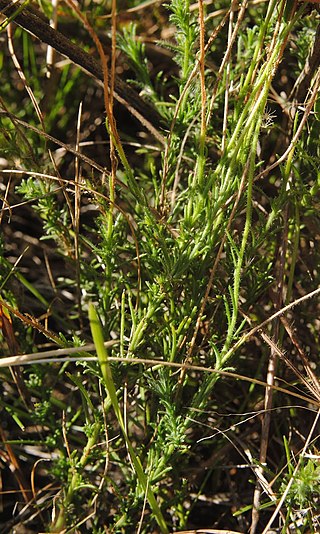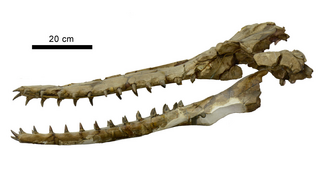
Senecio is a genus of flowering plants in the daisy family (Asteraceae) that includes ragworts and groundsels.

Kerriodoxa elegans, the white backed palm, is the only species of palm tree in the genus Kerriodoxa, in the family Arecaceae.

Bidens laevis is a species of flowering plant in the daisy family known by the common names larger bur-marigold and smooth beggarticks. It is native to South America, Mexico, and the southern and eastern United States. It grows in wetlands, including estuaries and riverbanks.

Hysterionica is a genus of flowering plants in the family Asteraceae.
Oplismenopsis is a genus of South American plants in the grass family. The only known species is Oplismenopsis najada, native to southern Brazil, Uruguay, and northeastern Argentina.
Pachylaena is a genus of South American flowering plants in the tribe Mutisieae within the family Asteraceae.

Chaetanthera is a genus of South American flowering plants in the family Asteraceae.

Carlo Luigi Spegazzini, in Spanish Carlos Luis Spegazzini, was an Italian-born Argentinian botanist and mycologist.

Zinnia elegans known as youth-and-age, common zinnia or elegant zinnia, is an annual flowering plant in the family Asteraceae. It is native to Mexico but grown as an ornamental in many places and naturalised in several places, including scattered locations in South and Central America, the West Indies, the United States, Australia, and Italy.

Hesperidanthus suffrutescens is a species of flowering plant in the mustard family. Its synonyms include Glaucocarpum suffrutescens. When placed in the genus Glaucocarpum, it was the only species. It is a rare species known by the common names toad-flax cress, shrubby reed-mustard, Uinta Basin waxfruit and waxfruit mustard. It is endemic to Utah in the United States, where it is known only from Duchesne and Uintah Counties. It is threatened by habitat degradation and destruction. It is federally listed as an endangered species of the United States.
Tagetes argentina is a South American plant species in the family Asteraceae. It is found in Argentina and Bolivia on granitic and rhyolitic soils.
Abundio Sagástegui Alva (1932–2012) was a Peruvian plant taxonomist and specialist of Asteraceae and the flora of Peru, particularly that of Northern Peru.

Ionopsis utricularioides, the delicate violet orchid, is an epiphytic orchid native to the warmer parts of the Americas. It is reported from Florida, Mexico, Central America, much of the West Indies including the Cayman Islands, South America as far south as Paraguay, and the Galápagos.

Narcissus serotinus is a autumn-flowering species of the genus Narcissus (daffodils) in the family Amaryllidaceae. It is classified in Section Serotini. It is native to Portugal, Spain, and Morocco. Records further east in the Mediterranean refer to Narcissus obsoletus and Narcissus elegans.
Tagetes laxa is a South American species of marigolds in the family Asteraceae. It is native to Bolivia and northern Argentina.

Phoberodon is a genus of archaic odontocete cetacean from the Early Miocene (Burdigalian) of Patagonia, Argentina.
Elsa Matilde Zardini (1949–2020) was an Argentinian-Paraguayan botanist, teacher, curator, and explorer. She made botanical expeditions in the US, Brazil, Argentina and Paraguay. Three botanical taxon names were authored by Zardini. Her specialization was the flora of the Plata basin, with an emphasis on that of Paraguay.

Mutisieae is a tribe of the family Asteraceae, subfamily Mutisioideae.

Genoveva Dawson was an Argentine botanist, curator, teacher, and explorer.
Phlyctaenopyga is an extinct genus of glyptodont. It lived from the Late Miocene to the Early Pliocene, and its fossilized remains were discovered in South America.












